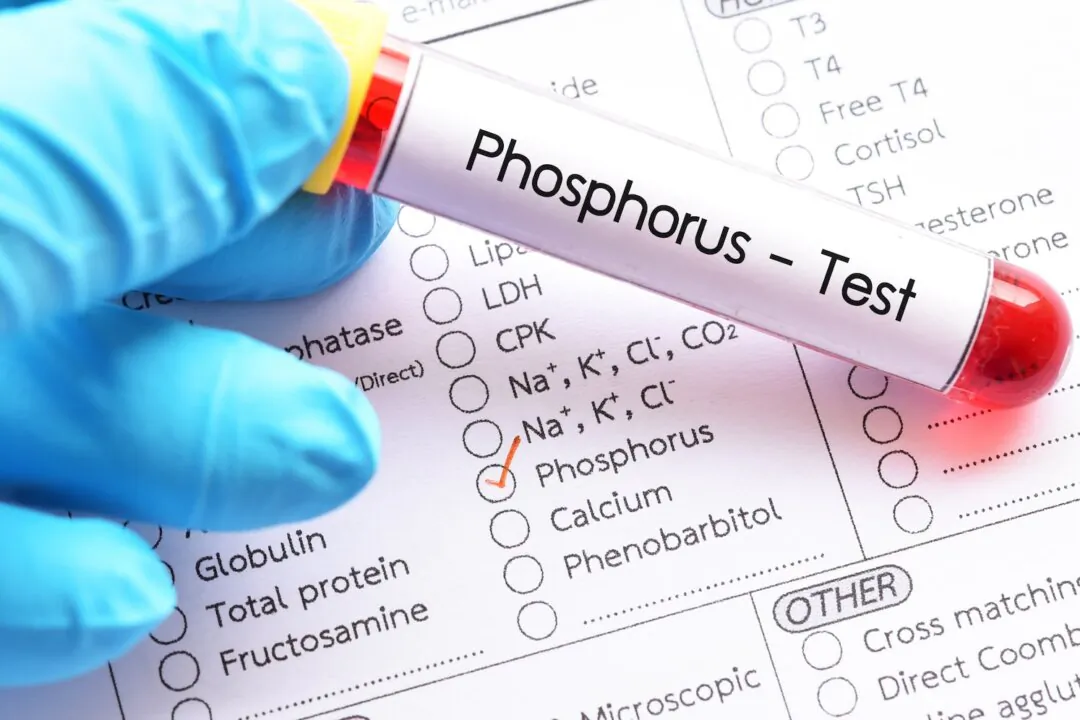Phosphorus, a non-metallic chemical element with the atomic number 15 on the periodic table, draws little attention. Most of us do not think twice about what phosphorus does in and around us—that is, in our bodies and our environment.
MIT (Massachusetts Institute of Technology) professor Christopher Cummins explains in an article on the chemistry department’s webpage: “Pure phosphorus P4 does not occur naturally because it is highly reactive. Phosphorus is mined from phosphate rock, […] basically animal bones and teeth.”
So, really, why should we care?
I want to be upfront. I am not a chemist. Therefore, forgive me when I fall short of scientifically explaining this quandary with the element “P.” While not a chemist, I am a holistic health practitioner and community herbalist, and in addition, a gardener and aspiring farmer. Within the realm of all these occupations, I am forced to think about phosphorus.
An article by Epoch Times author Kuo Pin Wu about kidney nourishment reminded me of that. Mr. Wu writes about “excessive dietary phosphorus intake” and phosphorus as a “legal food additive,” which prompted me to revisit notes I took during a recent seminar on water quality. Most of the three-hour-long class I attended covered phosphorus.
Allow me to explain why this topic needs our utmost attention.
The Phosphorus Dilemma
We need phosphorus. The element holds major functions in our cells and our tissues. Phosphorus helps develop, maintain, and repair. It is also needed for DNA and RNA production. Just like calcium, the body uses phosphorus to build our bones and teeth. Plus, the element assists in the regulation of mineral and vitamin levels.
In this way, we are comparable to plants. Phosphorus is a major plant nutrient. Plant cells require it to promote cell division and stimulate the development of the growing tip. Phosphorus transfers energy, nutrients, and genetic characteristics, and helps with photosynthesis and the transformation of starches and sugars.
However, a surplus of nutrients can become a problem for plants, the environment, and us.
Too Much of a Good Thing
In recent decades, the food industry has used inorganic phosphorus as an additive to increase the shelf-life of products and enhance their creaminess, decrease clumping in dry powders, or make some foods easier to melt.
Unfortunately, these values come at a cost. A 2018 commentary published in the Canadian Medical Association Journal and titled, “Inorganic Phosphate as a potential risk factor for chronic disease,” addresses the challenges of elevated serum-phosphate levels and their effect on kidney health.
The authors regret that although additives in food need to be clearly marked in Canada, enumerating the amount is not required. “Inorganic phosphate additives fall under the category of generally recognized as safe and as such are not subject to substantial premarket review or consistently imposed ceiling limits,” the statement reads.
As a result, the intake of dietary phosphates often appears only minimally linked to blood-phosphorus levels. A misleading conclusion, as insufficient data is often the real conundrum challenge.
A further review published by the European Food Safety Authority confirms this and cites in addition more complex problems—such as the intricate interplay between phosphorus and the endocrine system.
The parathyroid hormone (PTH), for instance, as well as vitamin D3’s 1,25-dihydroxyvitamin D, and fibroblast growth factor-23 all tend to normalize phosphate homeostasis—until they can’t—because of an onslaught of opposing forces, such as added dietary phosphate.
A detailed explanation of “serum inorganic phosphorus,” the biological processes around it, as well as phosphate homeostasis, can be found in Chapter 198 of the book “Clinical Methods.”
Homeostasis in and Around Us
Defined as a “self-regulating process by which a living organism can maintain internal stability while adjusting to changing external conditions,” homeostasis is the goal of living systems all around us.
Our bodies are part of those “living systems.” They consistently strive for equilibrium between elements to ensure proper functioning of all organs and systems. Such is also the case with internal phosphorus levels. However, the standard American diet (SAD) impedes that innate performance and hurts our kidneys in the process—the very organ that traditional Chinese medicine says holds the essence of life.
Kidneys Carry the Weight
While phosphorus absorption happens through the entire intestine, the major route of excretion is via the kidneys. One major job of healthy kidneys is to remove surplus phosphorus from our bodies, thereby, keeping phosphorus levels in the blood balanced (serum phosphorus homeostasis). Too much of that toil overexerts these eliminatory organs and diminishes their vital functions—to the point of damage, chronic kidney disease (CKD), or even organ failure.
Globally, 10 percent of adults endure CKD. In the United States, the malady reaches “more than 37 million Americans—about 1 in 7 adults” according to the National Institute of Diabetes and Digestive and Kidney Diseases.
Regrettably, many people are unaware of their kidneys’ suffering from long-term exploit or overburden. Even worse, silent kidney disease can lead to CKD-mineral bone disorder— a disease that throws mineral and hormone levels off balance and keeps the body in a continual process of repair.
A 2018 study published in the journal Nutrients explains the disease pathway. If the kidneys are kept from excreting higher than usual levels of phosphorus, hormonal changes would then cause compensation through the intestine. However, animal and human studies suggest that this tradeoff is not always the case, which “contributes to increased morbidity and mortality in these patients.”
These factors increase the need for heightened awareness, self-education, and adjustments in dietary consumption.
Managing Intake
As mentioned above, the standard American diet is generally high in food additives. Dietary sources of phosphorus include mostly staples high in protein, such as dairy products, meat, fish, and certain grains.
The average American diet is thought to consist of 1.0–1.5 grams of phosphorus per day. However, an editorial in Seminars in Dialysis outlines the drawbacks of the SAD and warns that the daily consumption of unlabeled additives might be double those figures.
The industry makes it hard for consumers to reach healthy, informed choices. According to a study in the Journal of Renal Nutrition, food products with additives were on average $2.00 cheaper than additive-free meals. Many customers shop based on price and will not go out of their way to search for hidden ingredients, or even know how to identify them.
The study also reviewed 2,394 best-selling food items—44 percent of which included phosphorus additives. Seventy-two percent of frozen meals contained added phosphorus, followed closely by 70 percent of dry-food mixes, and 65 percent of packaged meat. More than half of all bread and baked goods contained the chemical element.
Given all of these hidden additives, even kidney specialists frequently underestimate the dietary phosphorus ingestion by their patients.
Looking for the ‘Phos’
It would behoove consumers to read nutrition labels before purchasing food products. Be aware dietary phosphate additives go by many names, though all have the “phos” in common.
The National Kidney Foundation informs on its website about “Phosphorus and Your Diet” and provides the following list of phosphorus additives to watch for:
- Dicalcium phosphate
- Disodium phosphate
- Monosodium phosphate
- Phosphoric acid
- Sodium hexameta-phosphate
- Trisodium phosphate
- Sodium tripolyphosphate
- Tetrasodium pyrophosphate
Many bottled beverages contain added phosphorus, such as iced tea, chocolate drinks, and sodas. It can also be found in most prepackaged, processed foodstuff, deli meats, and other products high in protein, such as all dairy items.
Surprising to many, the culprit lurks not only in food items. Phosphorus additives are also found in the very pills concocted to help our ailments.
Phosphate in Medications
If you take prescription medication, especially when given multiple drugs at a time—as is often the case in people with kidney disease—chances are, you’re swallowing additives at the same time, including phosphorus.
Researchers evaluated 101 dialysis patients and reviewed 124 medications and found that “Central nervous system (CNS) and cardiovascular (CVS) medications accounted for 65% and 24% of phosphate-containing medications, respectively.” As 11 percent of the analyzed drug formulations contained phosphorus salts, the conclusion was that phosphorus additives in medication should be a deciding factor when drugs are prescribed.
Another team of scientists validates this dilemma and advises doctors to mind the phosphorus load in prescription drugs. Hypothetic modeling shows that patients who take multiple medications might have a phosphorus intake of ~766 mg more phosphate per day. This analysis does not consider any dietary sources of P.
Natural Support for the Kidneys
Eating a balanced, fresh, and whole food diet free from processed, additive-laden ingredients is half the battle won. Additionally, there are helpful phytopharmaceuticals that play a significant role in treating chronic kidney disease and aid kidney health and function.
A patented compound used in traditional Chinese medicine—Bupi Yishen Formula (BYF)—features eight herbal ingredients: Astragalus, Codonopsis, Atractylodis, Poria, Chinese yam, Coicis Semen, dodder seed, and red sage. The preparation has proven valuable in kidney disease therapy.
Although the function of the herbal composition and its multifaceted bioactive compounds could not be fully explained, research published in Frontiers in Pharmacology hailed the anti-inflammatory and renal fibrosis-reducing effects of BYF.
The paper lists the “BYF Water Extract Preparation” used in their study as:
[The herbal ingredients] “Astragali radix (30 g), Codonopsitis radix (15 g), Atractylodis macrocephalae rhizome (12 g), Poria (15 g), Diosscoreae rhizome (15 g), Coicis semen (20 g), Cuscutae semen (12 g), and Salviae miltiorrhizae radix et rhizome (15 g), were boiled twice (1 h each) in ddH2O (w/v). The extract was condensed and stored at −20 °C. Before treatment, the BYF extract was dissolved in distilled water.”
A 2022 study released in the Journal of Ethnopharmacology affirms the anti-fibrotic (anti-scarring) mechanisms of the Bupi Yishen Formula, which counters renal fibrosis and the progression of kidney disease.
A 2021 animal study attributed the herbal formula to attenuate kidney disease and to have a protective effect on kidneys.
No End to the Phosphorus Saga
Phosphorus and the consequences of its excessive use in foods and medications can be hard to navigate. Unfortunately, the health repercussions do not end here.
Frequently unnecessary phosphorus fertilizers are used in gardens and on lawns. If the soil is saturated, the element washes away as run-off or leaching.
Added phosphates are used in cleaning products to reduce the build-up of scum. When the cleaner goes down the drain, phosphorus enters the water cycle—our drinking water supply, rivers, and lakes.
One of the biggest problems with the mismanagement of phosphorus is eutrophication, destructive algal and cyanobacterial blooms, which not only threaten our clean water sources, but also lead to a degradation of our recreational areas for swimming, boating, and fishing. The effects of phosphorus are a threat to our ecosystems and human health.
Continue to learn about phosphorus and its health implications in our second article on phosphorus: “Excessive Phosphorus in Our Environment: Impacts on Human Health.”



